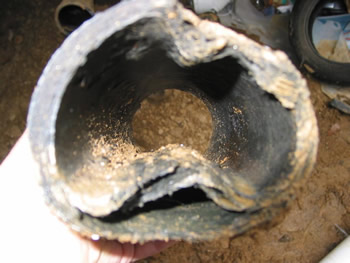 For most of the 20th century, oil heat was the primary method of heating homes. If you own or are considering purchasing a home that was built before 1965, chances are pretty good that the house had oil heat. And chances are also pretty good that the oil tank was buried in the ground.
For most of the 20th century, oil heat was the primary method of heating homes. If you own or are considering purchasing a home that was built before 1965, chances are pretty good that the house had oil heat. And chances are also pretty good that the oil tank was buried in the ground.
Should you be afraid to buy a home with an in-ground tank? No.
Should you be afraid of selling your home if it has an in-ground tank? No.
In both instances the necessary steps that you should take are clearly outlined by the Department of Environmental Quality. As a seller, you want to minimize your liability and be certain that once the house is sold, you will never have the old oil tank come back to haunt you. To do this, you must obtain soil samples to prove that the tank has not contaminated the surrounding soil. If the tank is still in use, the soil samples will prove that the tank had not contaminated the surrounding soil at the time that the house was sold. If tank is no longer in use, you are encouraged to have the tank decommissioned.
Decommissioning the tank involves emptying it of oil, cleaning it out, and filling it with concrete slurry that will harden into a big cement rock in the ground. While decommissioning the tank is voluntary, many lenders and most buyers will make this a condition of the sale. If you do not take the necessary steps to prove that the soil was clean at the time the house was sold, and soil samples taken later show that a contamination has occurred, you can be liable for the cost to clean up the soil even after the house has transferred to a new owner. So, take the proper steps now to assure that you will not have a problem in the future.
Whenever work is done on an in-ground tank, it should be performed by a licensed and bonded contractor who is certified with the DEQ. After the work is completed, a certificated of compliance will be issued. This is paperwork that needs to be saved and transfered with the property to every subsequent owner. Cost to do soil testing will run about $200-$400. Cost of decommissioning will run about $800 to $1,200. Can it cost more, yes, but that is a minority of the cases.
If you are wanting to buy a house with an in-ground oil tank, should you be afraid to purchase? No. Simply make the soil testing and the decommissioning of the tank a condition of the purchase. You are strongly advised to get this taken care of before you buy the house. If you buy the house with an in-ground tank, and you discover later that the tank has leaked, you have now taken ownership of the problem.
How bad can it get? There certainly are horror stories of soil clean up costs running into the thousands and thousands of dollars. In my 20 years of selling real estate, the most costly clean-up I have encountered involved bringing in a backhoe to remove a tank and dig a hole about 15 feet in diameter. It cost the seller $8,000.
Information on oil tanks are surprisingly undocumented. There are not good resources for looking up records about in-ground tanks. The DEQ does not regulate in-ground tanks beyond requiring that they be reported if they have leaked. Then, the DEQ does open a file on them and there is a process to clean up the contamination and get the file closed. However, if no leak has been reported to the DEQ, they will not have a record of the tank. And do not rely on city records or fire department knowledge of in-ground tanks. This means that even if a seller has no knowledge of an in-ground tank, you may want to consider having the yard of an older home scanned with a metal detector to confirm that no tank exists in the yard.
In all cases, it is best to take every precaution to be in compliance with soil testing and tank decommissioning when you buy or sell a home. Taking the proper steps now will save both buyers and sellers heartache later.

 On a recent Broker’s Tour in Lake Oswego, my cohorts and I were discussing how important it is to include accurate information in listings, and we noted how easy it is to inadvertently choose the wrong “field” when entering data etc. I thought it might help the prospective home seller or buyer to know a little about how agents search for houses, specifically in using the basic search fields provided to them on the MLS.
On a recent Broker’s Tour in Lake Oswego, my cohorts and I were discussing how important it is to include accurate information in listings, and we noted how easy it is to inadvertently choose the wrong “field” when entering data etc. I thought it might help the prospective home seller or buyer to know a little about how agents search for houses, specifically in using the basic search fields provided to them on the MLS. And, last but not least, remember that your Main Photo needs to be of your house on the MLS…
And, last but not least, remember that your Main Photo needs to be of your house on the MLS…
 What does this mean to you? It means that if you have your home priced according to what other homes in your neighborhood have sold for, and your home is clean and in good repair, you’ll sell your home at 8.5% over what it was worth a year ago and it will happen in about 80 days.
What does this mean to you? It means that if you have your home priced according to what other homes in your neighborhood have sold for, and your home is clean and in good repair, you’ll sell your home at 8.5% over what it was worth a year ago and it will happen in about 80 days. The Fibre Conduit Company of Orangeburg, N.Y. was a major manufacturer of this kind of pipe, and with its widespread use, changed its name to the Orangeburg Pipe Co. — thus the common name of the product. If your home was built during this period, there is a good chance that you have this kind of sewer pipe lurking underground, so it is good to know what this could mean to you as either a homeowner, or someone contemplating a purchase.
The Fibre Conduit Company of Orangeburg, N.Y. was a major manufacturer of this kind of pipe, and with its widespread use, changed its name to the Orangeburg Pipe Co. — thus the common name of the product. If your home was built during this period, there is a good chance that you have this kind of sewer pipe lurking underground, so it is good to know what this could mean to you as either a homeowner, or someone contemplating a purchase.